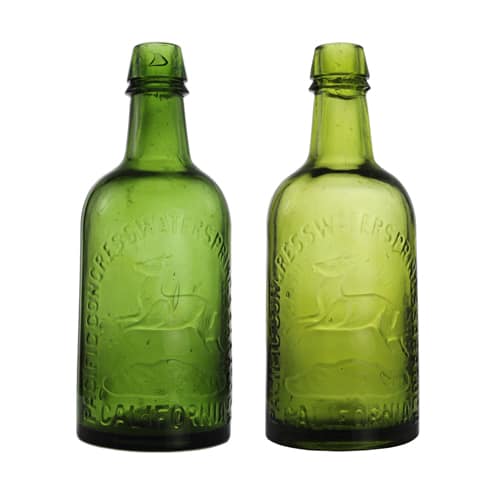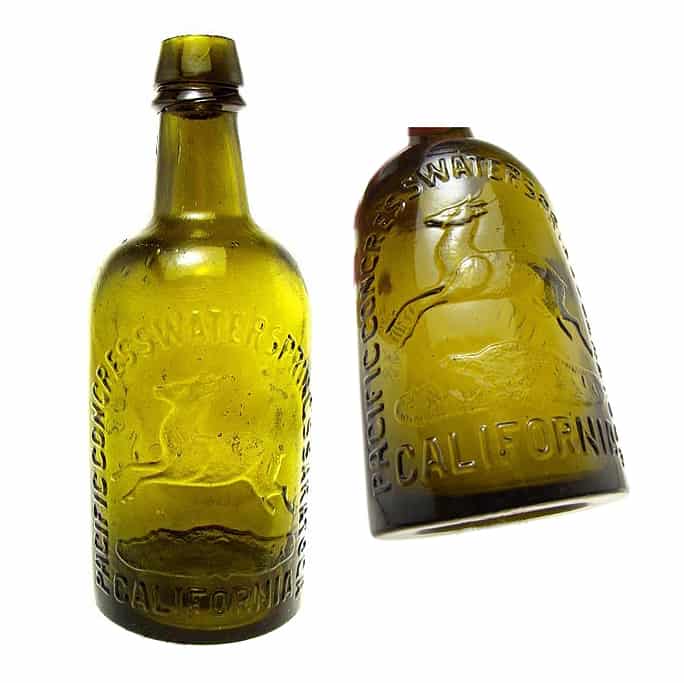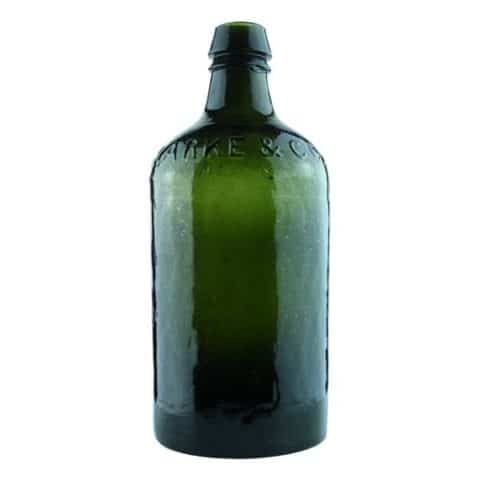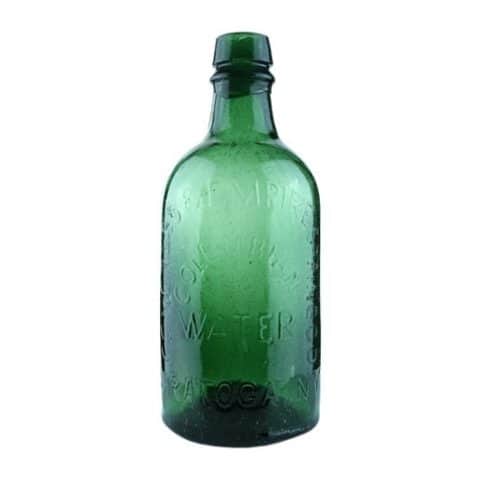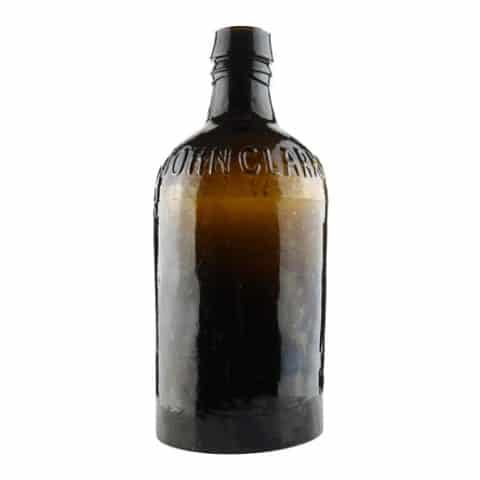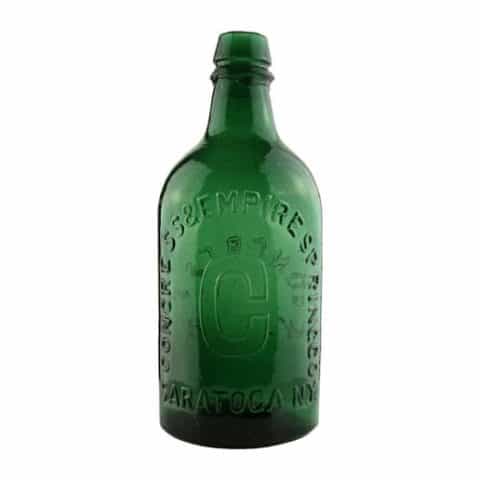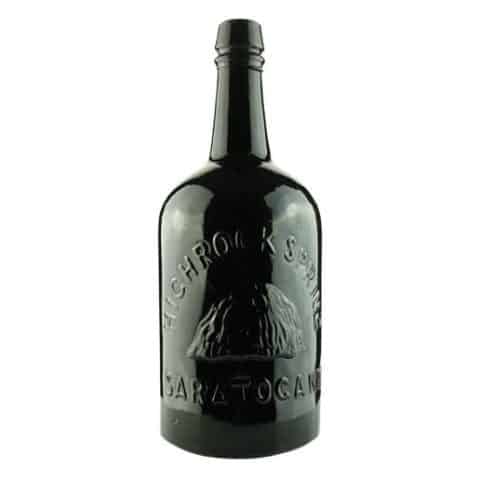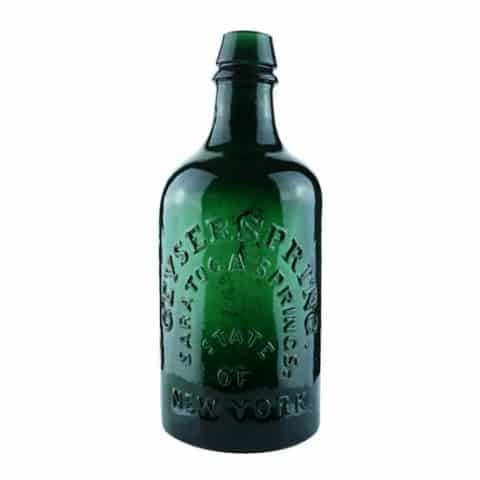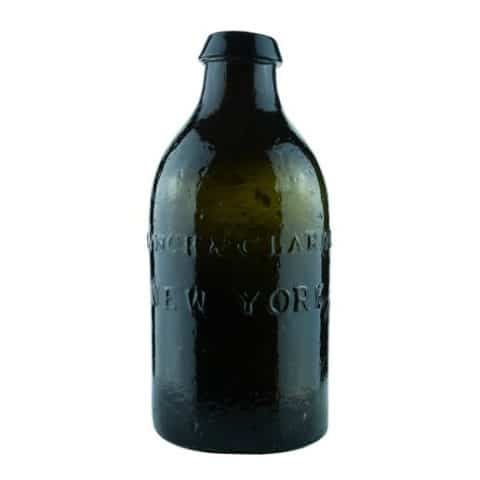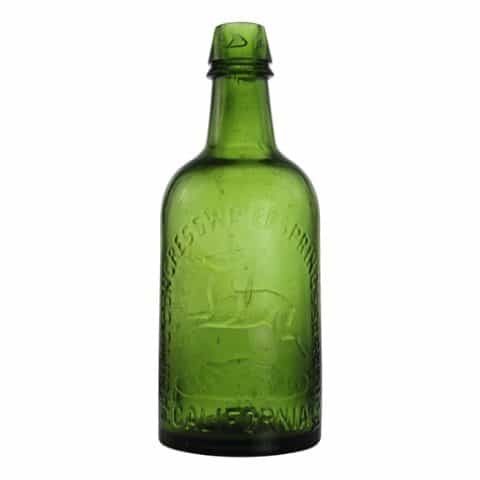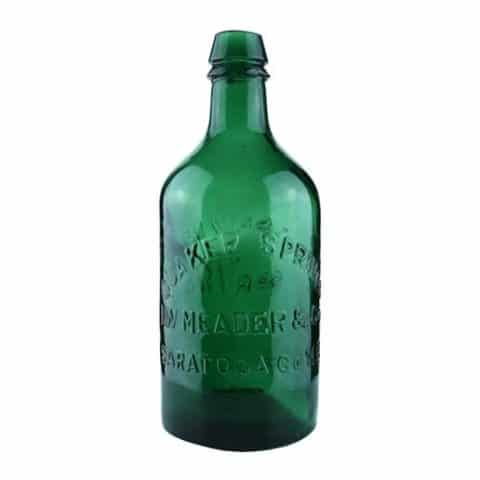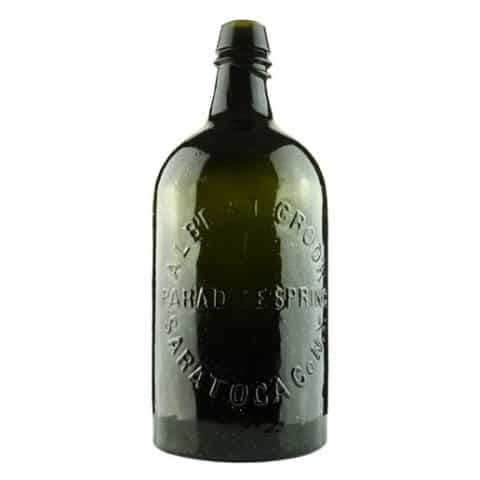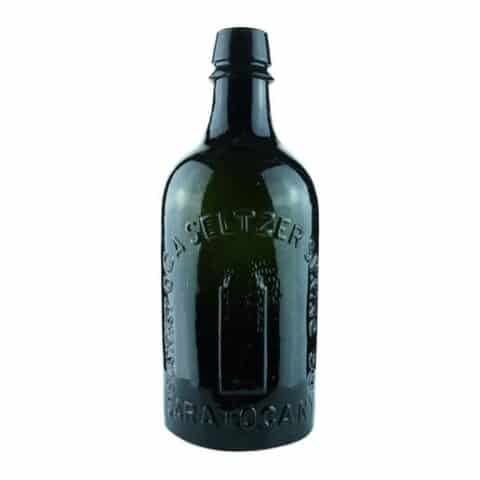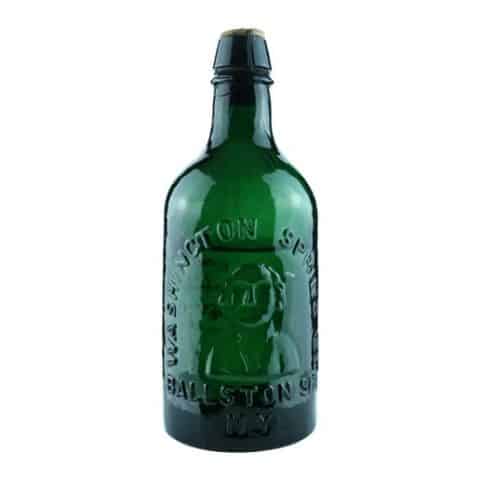Pacific Congress Water Springs (Running Deer)
Pacific Congress Water Springs Saratoga
(Motif Running Deer)
California
Sage’s Pacific Congress Springs
Lewis P. and Lewis A. Sage
Pacific Saratoga Springs, California
Light Olive Green Pint
Provenance: Lou Pellegrini Collection
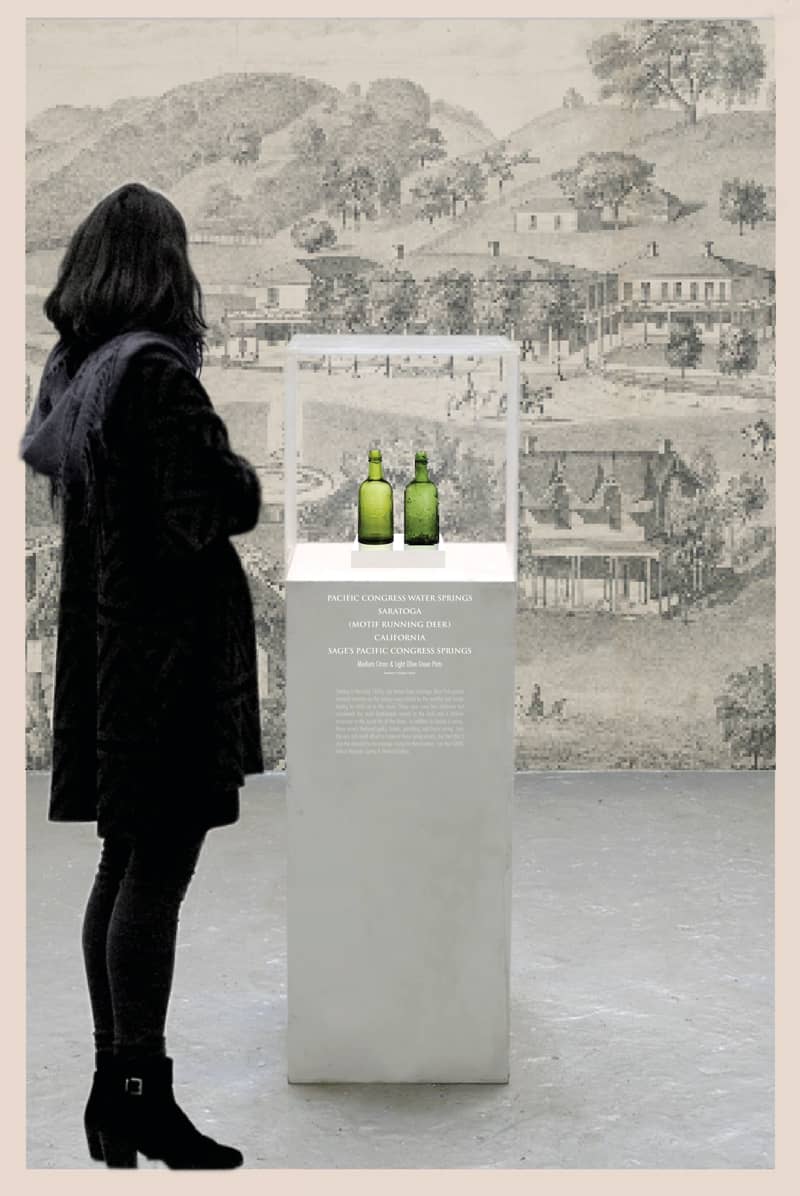
As early as 1767 in young America, water from Jackson’s Spa in Boston, Mass., was bottled and sold for medicinal purposes. The therapeutic regimen first introduced in ancient Rome spas was replicated in Bath, England, known for and named after the Roman-built baths.
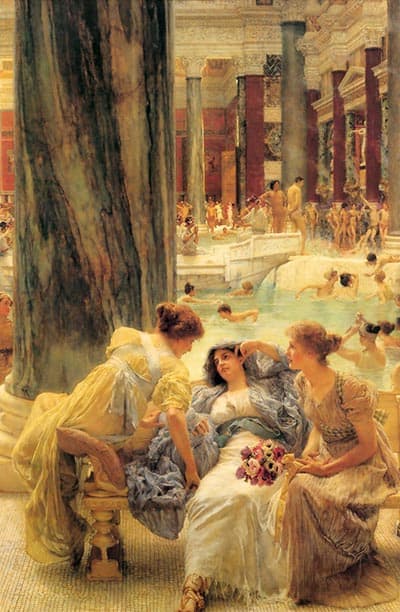
Starting in the early 1800s, spa waters from Saratoga, New York, gained national attention as the springs were visited by the wealthy and trendy, hoping to catch on to the craze. These spas were less elaborate but considered the most fashionable resorts in the land and a definite accessory to the social life of the times. In addition to having a spring, these resorts featured parks, hotels, gambling, and horse racing. Only the very rich could afford to frequent these spring resorts, but that didn’t stop the demand by the average citizen for these waters. See the FOHBC Virtual Museum Spring & Mineral Gallery.
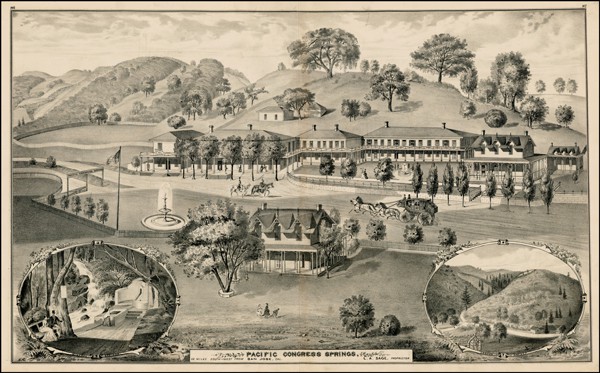
Pacific Congress Springs
In California, there were a dozen or so mineral springs in Santa Clara County, one of California’s original counties, formed in 1850 at the time of statehood. In the 1850s, Jud Caldwell discovered the springs named Pacific Congress Springs because the water had a mineral content similar to Congress Springs in Saratoga Springs, New York. The Pacific Congress Springs was situated in the coast range of mountains, 8 miles southwest of Santa Clara and 12 miles southwest of San Jose. In 1865, the town around Pacific Congress Springs voted to change its town name and post office to Saratoga.
Darius Ogden Mills, a prominent banker, and Alvina Hayward, a mining tycoon, formed a corporation and purchased 720 acres of Congress Springs from George Cross, a pioneer, for $2,000 in 1865. The carbonated water was bottled and sold in the western region for its medicinal, invigorating qualities and refreshing flavor. Mills and Hayward sold stock to finance building a public resort-type 14-room hotel they called the Pacific Congress Springs Hotel. The hotel and spa appealed to many and were immensely popular, especially nature lovers from the San Francisco Bay area.
See the museum example of Mills’ Bitters in the Bitters Gallery.
See the museum example of Mills’ Seltzer Springs in the Soda Water Gallery.
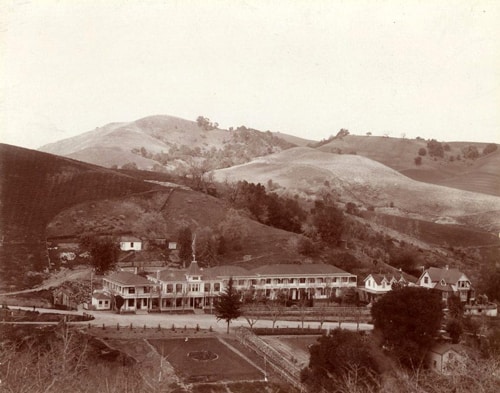
In 1872, Lewis A. Sage and his son bought the entire resort for $15,000 and later spent $15,000 on improvements. Under Sage’s management, the resort had its greatest popularity. Their dairy, orchard, and vineyard furnished milk, butter, fruit, and wine for the hotel’s tables. Sage advertised the baths, called Pacific Congress Springs, as efficacious in cutaneous diseases and rheumatic afflictions. The waters were tonic, purgative, diuretic alternatives—a cure-all for man’s diseases and afflictions, at least they said.
Read about another museum bottle, the San Jose Soda Works that actually has a misspelling on the bottle.
Pacific Congress Springs had its ups and downs over the years. In 1903, a fire destroyed the hotel. The hotel was never rebuilt, and by the mid-30s, the springs were closed to the public.
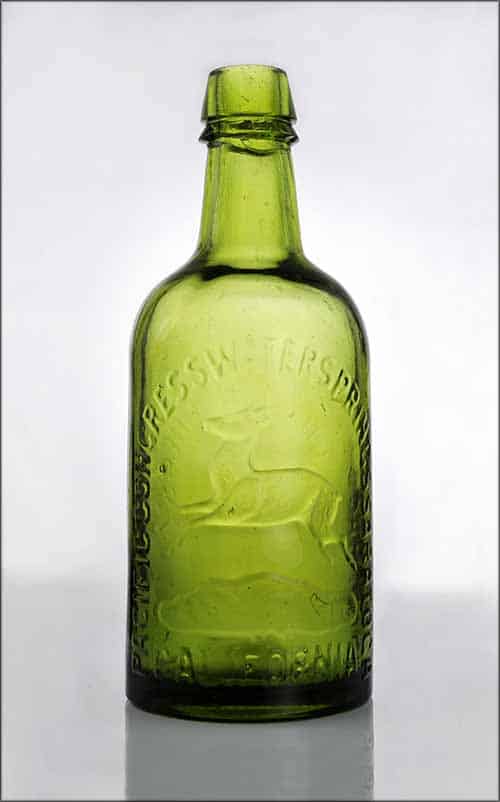
Pacific Congress Springs Bottle
There are three variants of the Pacific Congress Springs bottle. The earliest is embossed ‘PACIFIC CONGRESS SPRINGS.’ The bottle has some crudity and a slightly drippy blob top. This variant comes in ice blue, cobalt blue, greens, and black glass. These bottles were likely made at the original Pacific Glass Works in 1865.
The second and third variants were embossed prominently with a “running deer jumping over a rock” and have embossed copy on both sides of the bottle. You affectionately hear collectors referring to these bottles as “Running Deers.” There are not many pictorial mineral water bottles with an animal.
Our museum bottle is the third variant and came last as it has the word ‘SAGE’S’ embossed on the bottle. When looking at the bottle, on the obverse or deer side, the embossed copy reads ‘PACIFIC CONGRESS WATER SPRINGS SARATOGA’ in a tall domed horse-shoe arch starting at the bottom of the bottle and arching above and around the deer and terminating on the bottom of the bottle. Beneath the deer and rock is the embossed copy ‘CALIFORNIA’ set between the two vertical copy lines.
The reverse of the bottle has embossed copy, in three lines reading ‘SAGE’S PACIFIC CONGRESS SPRINGS.’ The first two lines are arched over a third straight line reading ‘SPRINGS.’ The lip finish differs slightly from the typical double tapered applied mouths with a more rounded lower collar on this third variant.
Both running deer variants come in yellow-green, medium emerald, shades of green, blue-green, olive, and everything in between. They were probably made at the San Francisco Glass Works between 1865 and the 1870s. The bottles can be found in pints and quarts.
San Francisco dig of 1998
During what is called “The Big Dig,” a cache of Pacific Congress Waters came from a single location in a downtown San Francisco dump. The dump was not a dump but a bottle-recycling plant from an earlier time. The bottles found were all oddballs, misfits that weren’t the regular shape of a generic bottle, a whiskey or soda, for instance. In other words, non-reusable. Instead, there were things like the Pacific Congress Springs, some without the running deer and some with, too distinct to re-use. Also found was the Bryant’s Stomach Bitters cone, Cassin’s Stomach Bitters, a new find in the name of AT&Co., the beautiful and elusive V. Squarza, the incredibly wonderful Dr. Parker’s Indian Tla-Quillaugh’s, and many, many more. All rare, with San Francisco heritage, exotic, and mostly very valuable.
Primary Images: Both Pacific Congress Water Springs Saratoga, California bottles were imaged by Gina Pellegrini at the FOHBC Virtual Museum west coast studio.
Support: Reference to 19th Century San Jose in a Bottle, Tobin Gilman, 2013
Support: Western Saratogas and the Pacific Congress Springs by Bryan Grapentine and Jeff Wichmann, Bottles and Extras, Summer 2005
Support Image: Second museum example of a Pacific Congress Water Springs Saratoga, California – Lou Pellegrini collection.
Support Image: Pacific Congress Springs, 12 Miles South-West From San Jose, Cal. 1876. A striking view of Pacific Congress Springs in Saratoga, California, from Thomson & West’s Historical atlas map of Santa Clara County, California. Compiled, drawn, and published from personal examinations and surveys by Thompson & West, San Francisco. – Barry Lawrence Ruderman Antique Maps, Inc.
Support Image: Pacific Congress Springs. Gorgeous deep aqua, heavy whittle, crude glass applied top. Western mineral water. Green streak in the neck. Double color top. Minor base ding or imperfection, otherwise a spectacular example. – Holabird Western Americana Collections, LLC.
Support Image: Pacific Congress Springs, Running Deer Mineral Water. This is the well-known deep lime green mineral water from California. A couple of decades ago, a monster hole was dug containing over a dozen specimens. This specimen has a small resin filled chip in the lip. Exceptionally clean, otherwise. Located 47 miles south of San Francisco. the property was written up in the Overland Monthly in 1870. The waters here were “charged with carbonic acid gas” which made them more “agreeable”, though they had an iron taste, according to Walton in “Mineral Springs of the US”, 1873 – Holabird Western Americana Collections, LLC.
Support Image: Pacific Congress Springs, Running Deer Mineral Water. Olive-green. – Jeff Wichmann, American Bottle Auctions
Join the FOHBC: The Virtual Museum is a project of the Federation of Historical Bottle Collectors (FOHBC). To become a member.

